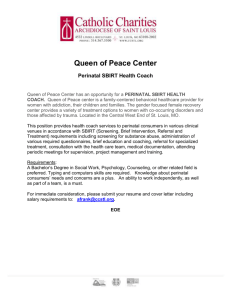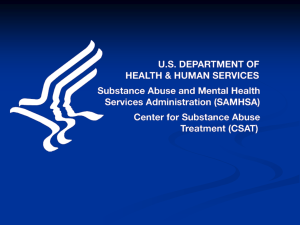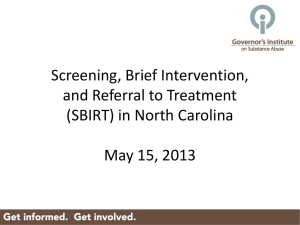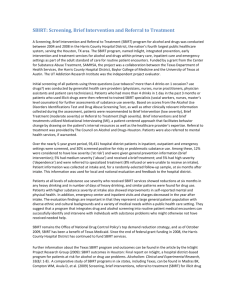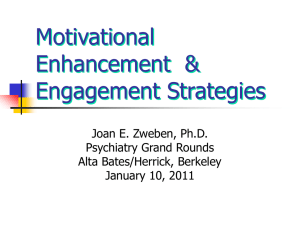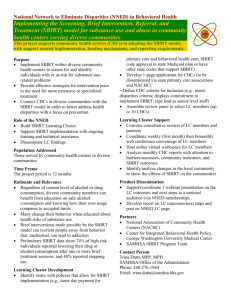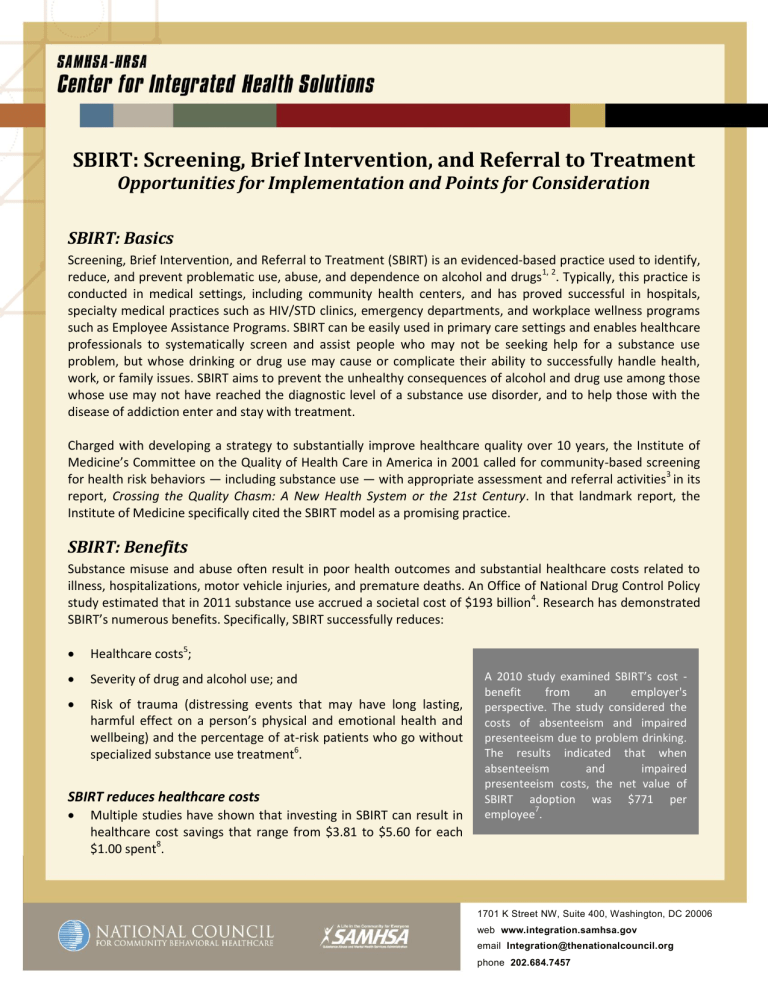
SBIRT: Screening, Brief Intervention, and Referral to Treatment Opportunities for Implementation and Points for Consideration SBIRT: Basics Screening, Brief Intervention, and Referral to Treatment (SBIRT) is an evidenced-based practice used to identify, reduce, and prevent problematic use, abuse, and dependence on alcohol and drugs1, 2. Typically, this practice is conducted in medical settings, including community health centers, and has proved successful in hospitals, specialty medical practices such as HIV/STD clinics, emergency departments, and workplace wellness programs such as Employee Assistance Programs. SBIRT can be easily used in primary care settings and enables healthcare professionals to systematically screen and assist people who may not be seeking help for a substance use problem, but whose drinking or drug use may cause or complicate their ability to successfully handle health, work, or family issues. SBIRT aims to prevent the unhealthy consequences of alcohol and drug use among those whose use may not have reached the diagnostic level of a substance use disorder, and to help those with the disease of addiction enter and stay with treatment. Charged with developing a strategy to substantially improve healthcare quality over 10 years, the Institute of Medicine’s Committee on the Quality of Health Care in America in 2001 called for community-based screening for health risk behaviors — including substance use — with appropriate assessment and referral activities3 in its report, Crossing the Quality Chasm: A New Health System or the 21st Century. In that landmark report, the Institute of Medicine specifically cited the SBIRT model as a promising practice. SBIRT: Benefits Substance misuse and abuse often result in poor health outcomes and substantial healthcare costs related to illness, hospitalizations, motor vehicle injuries, and premature deaths. An Office of National Drug Control Policy study estimated that in 2011 substance use accrued a societal cost of $193 billion4. Research has demonstrated SBIRT’s numerous benefits. Specifically, SBIRT successfully reduces: Healthcare costs5; Severity of drug and alcohol use; and Risk of trauma (distressing events that may have long lasting, harmful effect on a person’s physical and emotional health and wellbeing) and the percentage of at-risk patients who go without specialized substance use treatment6. SBIRT reduces healthcare costs Multiple studies have shown that investing in SBIRT can result in healthcare cost savings that range from $3.81 to $5.60 for each $1.00 spent8. A 2010 study examined SBIRT’s cost benefit from an employer's perspective. The study considered the costs of absenteeism and impaired presenteeism due to problem drinking. The results indicated that when absenteeism and impaired presenteeism costs, the net value of SBIRT adoption was $771 per 7 employee . 1701 K Street NW, Suite 400, Washington, DC 20006 web www.integration.samhsa.gov email Integration@thenationalcouncil.org phone 202.684.7457 People who received screening and brief intervention in an emergency department, hospital or primary care office experienced 20% fewer emergency department visits, 33% fewer nonfatal injuries, 37% fewer hospitalizations, 46% fewer arrests and 50% fewer motor vehicle crashes9. SBIRT decreases severity of drug and alcohol use In 2002, researchers analyzed more than 360 controlled trials on alcohol use treatments and found that screening and brief intervention was the single most effective treatment method of the more than 40 treatment approaches studied, particularly among groups of people not actively seeking treatment. Additional studies and reports have produced similar results showing that substance use screening and intervention help people recognize and change unhealthy patterns of use10. Studies have found that patients identified through screening as having unhealthy patterns of drug or alcohol use are more likely to respond to brief intervention than those who drink heavily 11. The latter group is more likely to meet diagnostic criteria for a substance use disorders that needs more intensive treatment. SBIRT reduces risk of physical trauma and the percentage of patients who go without specialized substance use treatment Studies on brief intervention in trauma centers and emergency departments have documented positive effects such as reductions in alcohol consumption,12 successful referral to and participation in alcohol treatment programs,13 and reduction in repeat injuries and injury hospitalizations14, 15. Given SBIRT’s demonstrated cost and health savings, federal agencies such as the Substance Abuse and Mental Health Services Administration (SAMHSA), Veterans Administration, Department of Defense and the White House Office of National Drug Control Policy, as well as managed care providers and major medical associations, have recommended SBIRT’s routine use. Not only does SAMHSA recommend SBIRT, but the agency also continues to support SBIRT’s expanded use by funding grants across the country to further implement the practice in healthcare settings. SBIRT: Core Components Screening Screening is a quick, simple method of identifying patients who use substances at at-risk or hazardous levels and who may already have substance use-related disorders. The screening instrument provides specific information and feedback to the patient related to his or her substance use. The typical screening process involves the use of a brief 1-3 question screen such as the National Institute on Alcohol Abuse and Alcoholism’s single question screen or National Institute on Drug Abuse’s quick screen. If a person screens positive on one of these instruments, s/he is then given a longer alcohol or drug use evaluation, using a standardized risk assessment tool such as AUDIT or ASSIST. The screening and risk assessment instruments are easily administered and provide patient-reported information about substance use that any healthcare professional can easily score. Brief Intervention Brief Intervention is a time-limited, patient-centered strategy that focuses on changing a patient’s behavior by increasing insight and awareness regarding substance use. Depending on severity of use and risk for adverse consequences, a 5-10 minute discussion or a longer 20-30 minute discussion provides the patient with 1701 K Street NW, Suite 400, Washington, DC 20006 web www.integration.samhsa.gov email Integration@thenationalcouncil.org phone 202.684.7457 personalized feedback showing concern over drug and/or alcohol use. The topics discussed can include how substances can interact with medications, cause or exacerbate health problems, and/or interfere with personal responsibilities16. Brief intervention is designed to motivate patients to change their behavior and prevent the progression of substance use. During the intervention, patients are: Given information about their substance use based on their risk assessment scores. Advised in clear, respectful terms to decrease or abstain from substance use. Encouraged to set goals to decrease substance use and to identify specific steps to reach those goals. Taught behavior change skills that will reduce substance use and limit negative consequences. Provided with a referral for further care, if needed. Brief interventions are typically provided to patients with less severe alcohol or substance use problems who do not need a referral to additional treatment and services. In addition to behavioral health professionals, medical personnel (e.g., doctors, nurses, physician assistants, nurse practitioners) can conduct these interventions and need only minimal training. In the case of patients with addictions, more intensive interventions may be needed. Much of the discussion in intensive intervention is similar to that of the brief intervention; however, the intensive sessions tend to be longer (20-30 minute) and can include multiple sessions, a referral to an addiction specialty program, and the addition of a specific pharmacological therapy. While medical personnel who have received additional training may conduct intensive interventions, behavioral health professionals often conduct these longer counseling sessions. Referral to Treatment In some cases, a more advanced treatment option is necessary and the patient is referred to a higher level of care. This care is often provided at specialized addiction treatment programs. The referral to treatment process consists of helping patients access specialized treatment, selecting treatment facilities, and facilitating the navigation of any barriers such as cost of treatment or lack of transportation that would hinder them from receiving treatment in a specialty setting. In order for this process to occur smoothly, primary care providers must initially establish and cultivate relationships with specialty providers, and then share pertinent patient information with the referral provider. Handling the referral process properly and ensuring that the patient receives the necessary care coordination and follow-up support services is critical to the treatment process and to facilitating and maintaining recovery. SBIRT: Opportunities and Points for Consideration The passage of the Patient Protection and Affordable Care Act in 2010 availed several opportunities for service delivery and payment reform in healthcare, including recognition of the importance of screening and intervention in primary care to reduce disease, disability and premature mortality. As of October 14, 2011, Medicare covers screening and behavioral counseling related to alcohol misuse in the primary care setting, which the U.S. Preventive Services Task Force recommended with a grade of B. In its 1701 K Street NW, Suite 400, Washington, DC 20006 web www.integration.samhsa.gov email Integration@thenationalcouncil.org phone 202.684.7457 Decision Memo for Screening and Behavioral Counseling Interventions in Primary Care to Reduce Alcohol Misuse, the Centers for Medicare and Medicaid Services (CMS) conclude that these services are “reasonable and necessary for the prevention or early detection of illness or disability”17. Medicare entitles beneficiaries to yearly alcohol screenings by a primary care provider and up to four behavioral counseling interventions18. Additionally, in December 2011, the U.S. Department of Health and Human Services (HHS) issued its first round of guidance on how states and health plans are to implement the Essential Health Benefits (EHBs) provisions of the Affordable Care Act. The Essential Health Benefits are a set of healthcare service categories that must be covered by all insurance policies participating in state health insurance exchanges and all state Medicaid plans beginning in 2014. As required by the Affordable Care Act, the EHB package must include mental health and substance use disorder services at parity with other medical/surgical care, prevention services, and rehabilitative services. However, rather than designing one standard benefit package for all health plans in the nation to follow, HHS proposed to allow states to define their own essential health benefits. States would have 10 options for selecting a “benchmark” plan in which its covered Even with reimbursement codes benefits would be the basis of that state’s EHB package. While the available, it is important to note that package must include mental health and substance use disorder some states may still have difficulty services, each state will determine the extent of coverage. The covering screening and brief development of the EHB package is a prime opportunity to promote the intervention services when they are provided by non-physician inclusion of SBIRT across multiple healthcare settings. However, professionals. According to a inclusion of these services may be dependent upon action at the state SAMHSA learning collaborative run by level. Stakeholders should pay close attention to further guidance the National Network to Eliminate released by HHS, as well as opportunities within their own state to Disparities, Federally Qualified Health influence the process. Centers (FQHCs) in Tennessee and Colorado received reimbursement from insurance carriers only when SBIRT services were conducted by primary care physicians and not when provided by psychologists or social workers. As it turned out, this caveat was included in the criteria for payment in these states. Once identified, both states were able to change their payment methodologies to correct this problem. In Colorado, health educators are now able to receive payment for delivering screening and brief intervention. Utilizing SBIRT Reimbursement Codes SBIRT is an effective method to identify, intervene and help treat individuals with substance use problems. Its use across healthcare settings, including emergency rooms, community clinics and trauma centers, is paramount. Hence, SBIRT coding and billing policies are a crucial component to widespread use of this practice. However, coding and reimbursement are dependent upon the payer type; reimbursement is available through commercial insurance Current Procedural Terminology (CPT) codes, Medicare G codes, and Medicaid Healthcare Common Procedure Coding System (HCPCS) codes19. While Medicare currently pays for screening and brief intervention as a preventive service in the primary care setting, some states are working to “activate” Medicaid codes for SBIRT reimbursement. According to the most recent information from SAMHSA, 16 states have approved SBIRT codes in their respective Medicaid plans; of these, five states have activated codes that allow providers to bill and receive payment for the services, four have activated SBIRT codes to allow for reimbursement of non-physician professionals, including Alaska, Tennessee, Colorado, and Virginia, and two states — Indiana and Oklahoma — have activated SBIRT codes to allow for reimbursement of physicians only. 1701 K Street NW, Suite 400, Washington, DC 20006 web www.integration.samhsa.gov email Integration@thenationalcouncil.org phone 202.684.7457 SAMHSA has funded a number of state SBIRT initiatives and has found that SBIRT programs can be implemented successfully in primary care settings20. However, sustainability can pose a problem once a grant-funded project ends. Addressing SBIRT reimbursement barriers not only expands the use of SBIRT, but also assists in the sustainability of providing these services in the primary care setting. More information on SBIRT billing codes may be found through the Institute for Research, Education &Training Institute in Addictions, CMS and the SAMHSA-HRSA Center for Integrated Health Solutions. Addressing Workflow Issues In addition to reimbursement issues, SBIRT proponents encounter other barriers to broad implementation and sustainability of this evidence-based practice. In Maryland, efforts to integrate SBIRT into community health centers demonstrate the importance of resolving workflow hurdles and providers’ time constraints in the primary care setting. Through an Open Society Institute-funded pilot project in 2010, four community health centers in Baltimore engaged in a workflow redesign process that resulted in successful institutionalization of SBIRT practices in their centers. Through this process, key lessons learned were that administrative and physician champions are essential to early adoption and that recognizing the role of technology was critical. As a result, the Baltimore SBIRT pilot supported sites in incorporating SBIRT screening into their electronic health records. This produced a dramatic improvement in delivery of brief interventions and facilitated ease in documentation and data collection. One common barrier to implementing SBIRT in primary care settings is the additional time the practice will add to already short visits. As indicated above, the Baltimore SBIRT project overcome this hurdle by employing multidisciplinary change team to identify not only the best screening and risk assessment tools for that practice setting, but also which existing clinical and administrative staff would conduct specific SBIRT functions. This led to the creation of several different SBIRT delivery models across seven community health centers in 14 separate locations across the state of Maryland. In some models, medical assistants complete the screening and risk assessment tools with patients; then, the primary care provider reviews the information and conducts the brief intervention. In other health centers, the primary care provider conducts only part of the brief intervention for each patient and refers to internal behavioral health professionals for completion. The success of the Maryland health center project led Baltimore Substance Abuse Systems, Inc., the lead funder of substance abuse treatment for the city, to fund SBIRT projects in six high schools and one emergency department. These efforts are currently underway. The keys to Maryland’s successful implementation have included collaboration with health staff to tailor SBIRT to existing infrastructure and resources, ongoing training, data collection for quality monitoring and process revision based on results. Visit SAMHSA-HRSA Center for Integrated Health Solutions for resources that address workflow issues. Maintaining Confidentiality As SBIRT’s use advances, patient privacy must be carefully considered as data collected through the screening process by healthcare organizations other than addiction specialty programs are not covered by 42 CFR. Providers must ensure that all applicable safeguards are in place to protect patient data. 1701 K Street NW, Suite 400, Washington, DC 20006 web www.integration.samhsa.gov email Integration@thenationalcouncil.org phone 202.684.7457 SBIRT: Adapting to the Health Home Model Under the Affordable Care Act, states have the option to establish a “health home” to better meet the healthcare needs of individuals with chronic conditions. As stipulated by the federal government, these health homes must provide comprehensive, evidence-based care and provide mental health and substance use prevention and treatment services. CMS has released guidance on the development of health homes, (available on SAMHSA’s health homes webpage). Hence, as states move forward with implementing health home initiatives, an opportunity exists to significantly expand the use of SBIRT services to provide more comprehensive care to the individuals that are served through these models. The state of New York in its Health Home State Plan Amendment (SPA) and in proposals to transform their Medicaid system have proposed a significant expansion of the use of SBIRT. It is the state’s hope that this expansion will lead to early interventions before more severe and costly consequences occur from alcohol and drug misuse. The state of Missouri has also taken a similar approach in the development of its Health Home SPA by identifying the use of SBIRT as a critical component of addressing the health needs of Missouri’s low-income populations and those living with chronic medical and behavioral health conditions. Stakeholders must educate state Medicaid directors on the benefits of incorporating SBIRT services into health home models and allowing psychologists and licensed social workers to bill for these services. As mentioned, Alaska, Tennessee, Colorado, and Virginia have successfully worked with state Medicaid programs to activate SBIRT billing codes to allow reimbursement for non-physician professionals. Stakeholders interested in receiving technical assistance and consultation around the Health Home SPA can contact the Substance Abuse and Mental Health Services Administration. SBIRT: Implications The cost of healthcare in the U.S. has been steadily growing and providers, policy makers and consumers are eager to identify high quality, cost-effective strategies to coordinate the care of individuals and manage chronic illnesses21. SBIRT is an evidence-based practice that has been clinically shown to identify, reduce and prevent substance misuse and the disease of addiction and ultimately reduce healthcare costs. While implementation barriers still exist, recent developments under the Affordable Care Act have created valuable opportunities for the expansion of SBIRT utilization across various healthcare settings. As states begin to explore opportunities through the Health Homes SPA, stakeholders must recognize SBIRT’s value and the need to implement the practice to comprehensively address consumers’ health needs. Through the use of evidence-based practices such as SBIRT, individuals will receive quality care that will lead to improved population health outcomes. SBIRT: Additional Resources SAMHSA-HRSA Center for Integrated Health Solutions Substance Abuse and Mental Health Services Administration Centers for Medicaid and Medicare Services National Institute on Alcohol Abuse and Alcoholism The Big Initiative Foundations of SBIRT 1701 K Street NW, Suite 400, Washington, DC 20006 web www.integration.samhsa.gov email Integration@thenationalcouncil.org phone 202.684.7457 1. 2. 3. 4. 5. 6. 7. 8. 9. 10. 11. 12. 13. 14. 15. 16. 17. 18. 19. 20. 21. Bien, T. H., Miller, W. R., & Tonigan, J. S. (1993). Brief intervention for alcohol problems: A review. Addiction, 88, 315–335 Madras BK, Compton WM, Avula D et al. Screening, brief interventions, referral to treatment (SBIRT) for illicit drug and alcohol use at multiple healthcare sites: Comparison at intake and six months later. Drug and Alcohol Dependence 2009; 280‐295. Institute of Medicine, Committee on Quality of Health Care in America (IOM). Crossing the Quality Chasm: A New Health System st for the 21 Century. Washington, DC, 2001. National Drug Intelligence Center (2011) The Economic Impact of Illicit Drug Use on American Society. Washington D.C.: United States Department of Justice. Quanbeck A, Lang K, Enami K, & Brown RL. (2010). A cost-benefit analysis of Wisconsin's screening, brief intervention, and referral to treatment program: adding the employer's perspective. State Medical Society of Wisconsin, Feb; 109(1):9-14 Gentilello, L.M., Ebel, B.E., Wickizer, T.M., Salkever, D.S. & Rivara, F.P. (2005). Alcohol intervention for trauma patients treated in emergency department and hospitals: a cost benefit analysis. Annals of Surgery, 241 (4), 541-550 Quanbeck A (2010) Fleming, M. F., Mundt, M. P., French, M. T., Manwell, L. B., Stauffacher, E. A., & Barry, K. L. (2000). Benefit-cost analysis of brief physician advice with problem drinkers in primary care settings. Medical Care, 38(1), 7–18. ibid Miller, W.R., & Wilbourne, P.L. (2002). Mesa Grande: a methodological analysis of clinical trials of treatments for alcohol use disorders. Addiction, 97, 265–277 Fleming M (2000) Gentilello, L. M. (2007). Alcohol and injury: American College of Surgeons Committee on Trauma requirements for trauma center intervention. Journal of Trauma, 62, S44–S45 Gentilello, L. M., Rivara, F. P., Donovan, D. M., Jurkovich, G. J., Daranciang, E., Dunn, C. W., et al. (1999). Alcohol interventions in a trauma center as a means of reducing the risk of injury recurrence. Annals of Surgery, 230, 473–483 ibid Soderstrom, C. A., DiClemente, C. C., Dischinger, P. C., Hebel, J. R., McDuff, D. R., Auman, K. M., et al. (2007). A controlled trial of brief intervention versus brief advice for at-risk drinking trauma center patients. Journal of Trauma, 62, 1102–1112. Institute for Research, Education and Training in Addictions (undated) SBIRT, Screening, Brief Intervention, and Referral to Treatment. www.ireta.org/sbirt/1_multipart_xF8FF_4_sbirt.pdf Centers for Medicare and Medicaid Services. (2011). Decision memo for screening and behavioral counseling interventions in primary care to reduce alcohol misuse. www.cms.gov/medicare-coverage-database/details/nca-decisionmemo.aspx?NCAId=249 Centers for Medicare and Medicaid Services. (2011). Medicare Claims Processing Manual: Chapter 18 - Preventive and Screening Services. Available at: www.cms.gov/Regulations-and-Guidance/Guidance/Manuals/downloads//clm104c18.pdf Ensuring Solutions to Alcohol Problems (2008). The Promise of the New Reimbursement Codes. The George Washington University Medical Center. Available at: www.ensuringsolutions.org/moreresources/moreresources_show.htm?doc_id=672933 Substance Abuse and Mental Health Services Administration (2011). Screening, Brief Intervention and Referral to Treatment (SBIRT) in Behavioral Healthcare. Available at: www.samhsa.gov/prevention/sbirt/SBIRTwhitepaper.pdf Kaiser Family Foundation. (2011). Health Care Spending in the United States and Selected OECD Countries. Available at: www.kff.org/insurance/snapshot/oecd042111.cfm 1701 K Street NW, Suite 400, Washington, DC 20006 web www.integration.samhsa.gov email Integration@thenationalcouncil.org phone 202.684.7457
